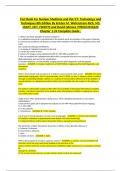Exam (elaborations)
Nuclear Medicine and Pet/CT: Technology and Techniques 8th Edition By Kristen M. Waterstram-Rich, MS, CNMT, NCT, FSNMTS and David Gilmore 9780323356220 Chapter 1-24 Complete Guide .
- Course
- Institution
- Book
Nuclear Medicine and Pet/CT: Technology and Techniques 8th Edition By Kristen M. Waterstram-Rich, MS, CNMT, NCT, FSNMTS and David Gilmore 9780323356220 Chapter 1-24 Complete Guide .
[Show more]



